Abdelhamied Y Saad1*, Leslie P Gartner2
1Professor of Oral Histology and Dental Anatomy/Endodontics, Faculty of Dental Medicine, Al-Azhar University, Cairo, Egypt
2Professor of Anatomy/Histology, Dental School, University of Maryland, Baltimore, Maryland, USA
*Correspondence author: Abdelhamied Y Saad, Professor of Oral Histology and Dental Anatomy/Endodontics, Faculty of Dental Medicine, Al-Azhar University, Cairo, Egypt; E-mail: [email protected]
Published Date: 29-07-2024
Copyright© 2024 by Saad AY and Gartner LP. All rights reserved. This is an open access article distributed under the terms of the Creative Commons Attribution License, which permits unrestricted use, distribution, and reproduction in any medium, provided the original author and source are credited.
Abstract
No Previous investigation examined the histological effects of nicotine on mandible development in mouse. Therefore, fetuses of pregnant CD-1 mice, exposed to 0.1% nicotine sulfate at a dose of 1.67 mg/kg body weight from the 6th to the 15th gestational day, were compared with controls (Saline-injected and untreated) fetuses. This to assess the histologic effects of nicotine on mandibular osteogenesis. Mothers were sacrificed on the 18th day of gestation. The 180 decapitated nicotine-treated heads as well as the 348 control heads were measured (height, width and circumference), embedded in paraffin, sectioned in the frontal plane, 5 µm thick and stained with H&E for light microscopic examination. Data analysis revealed the head dimensions were significantly reduced in nicotine treated heads when compared to those of controls. Histologic examination demonstrated 9.6% of fetuses of experimental heads presented cleft palate, whereas none of the controls had that anomaly. Furthermore, development of the mandibles, with or without clefts, appear retarded, bony elements were smaller and less dense in experimental fetuses when compared to those of control groups. It was concluded that nicotine has a detrimental effect on head size and mandibular osteogenesis of CD-1 albino mice.
Keywords: Head Size; Mandible Development; Mouse; Nicotine
Short Title: Effects of nicotine on mandible osteogenesis.
Introduction
The mandible of the mouse derived from the first visceral arch [1]. Neural crest cells migrate to the presumptive face to form the mesenchyme of the mandibular processes [2,3]. The mandibular processes grow anteriorly and medially and subsequently fuse with each other forming the future mandible at approximately 15-15.5 intrauterine day [1,4-6].
Cigarette smoke contains approximately 4000 toxic compounds including nicotine. Administration of nicotine to pregnant animals (rodents) or humans appear to cause adverse effect on the developing fetus especially the craniofacial structures. This disturbs proper development of the mandible followed by malformation of maxilla and palate [7, 8]. Furthermore, nicotine may suppress fetal growth, increase perinatal mortality, decrease fetal weight, reduce crown-rump length, decrease the litter size and lower head size. [7-11].
Nicotine administration to pregnant animal, especially rodents, has been associated with several adverse effects on oral and para-oral structures. Several investigators have revealed that nicotine injected to pregnant animals produced fetuses with cleft palate, malformed incisors, retarded first molar tooth development, poorly developed tongue [12-17]. Moreover, fetal exposure to nicotine on development of the hard tissues of the first molar crown of laboratory rats, during and after the fetal cycle, revealed significant decrease in length, width and occlusal areas, compared to control rats [18]. In addition, it has established the effects of nicotine begin prenatally and extend postnatally, in incisors and molars development and even in the craniofacial skeleton [7,19,20]. Furthermore, mouse first molar tooth germs treated with high dose of nicotine in organ culture produced extensive cell damage in dental papilla and more in enamel organ and failed to produce extracellular matrix compared to untreated control group [21].
Histologic investigations of the effects of fetal exposure to nicotine on development of mandible of rodents are lacking. Therefore, the purpose of the current study was to determine the effects of 0.1% nicotine sulfate, intraperitoneally injected into pregnant CD-1 mice, on days 6-15 of gestation, on head size and developing mandible of their fetuses.
Material and Methods
CD-1 Swiss albino mice (Charles River, USA) maintained in a controlled environment of 22°c with equal light and dark periods changed at the 9 o’clock hour and received food and water ad libitum. Mice were mated overnight from 5 PM to 9 AM and the day of separation was determined to be day 0 of pregnancy. Pregnant mice were separated into three groups: experimental (N=18), saline injected controls (N=19) and non-injected controls (N=22). The first group was injected intraperitoneally with 0.1% nicotine sulfate (Sigma) diluted in sterile physiological saline. Each experimental animal received 1.67 mg of nicotine sulfate per kg of body weight from day 6 to day 15 of gestation. The injected controls received the equivalent volume of sterile saline, whereas the noninjected controls were handled in a similar manner. Injection occurred at 9 AM and the site of injection was changed frequently in order to prevent the possible occurrence of localized irritation.
Pregnant mice were sacrificed via chloroform inhalation on the eighteenth day of gestation. Fetuses removed by laparotomy, decapitated and maximum head heights and width were established by the use of a Twanson Spring Caliper and maximum head circumference was measured by wrapping a soft plastic roller around the head of the fetus. Measurements were statistically analyzed using One Way ANOVA and Duncan’s Multiple Range Test. Fetuses were then decapitated and were fixed in Dietrich’s fixative for nine days. Subsequent to fixation, the heads were prepared for embedment in paraffin. Blocks were serially sectioned (5 um) in the coronal plane and the sections were stained with hematoxylin and eosin. Microscopic examination of the mandibles was performed to determine the histologic variation between the experimental and control groups (both with and without palatal cleft).
Results
Only 2 of 166 fetuses were dead on day 18 of pregnancy of experimental group, while no dead fetuses were observed in either saline-treated (N=198) or untreated groups (N=232). Furthermore, the head measurements of 166 nicotine-treated fetuses were significantly less (P<0.00001) than those of 198 Saline – treated and 232 untreated fetuses. (Table 1, Fig. 1). In addition, nicotine injected pregnant mothers were significantly (P<0:00001) more likely to produced more fetuses with cleft palate (9.68%), than did the controls, since no cleft palates were observed in either saline-treated or untreated animals. Generally, bony elements of the lower jaw appeared smaller and less dense in experimental fetuses when compared to those of control groups (Fig. 2-5). No noticeable differences were observed in mandibles of the two control groups (Fig. 6,7).
The results also indicated that the mandibles of the experimental group, with or without cleft palate, were less developed than those of control groups. Nicotine-treated mandibles were smaller in size, possessed smaller and less dense bony trabeculae with few osteoblasts. Bony trabeculae, encircling Meckel’s cartilages of the experimental animals, were also reduced in size and displayed a less organized arrangement. Incisor and molar tooth germs were encompassed by poorly developed bony crypts. Bony elements of the ascending ramus were retarded and reduced in size. Control fetuses, on the other hand, demonstrated well developed mandibles of considerable size and well-organized bony trabeculae. These trabeculae were surrounded by numerous osteoblasts and housed several osteocytes indicating more osteoblastic activities than that observed in the experimental group. Anteriorly, Meckel’s cartilages appeared fused in the midline. Posteriorly, bony trabeculae of the mandible were observed and this was not evident in the experimental group. Incisor and molar tooth germs of the control groups were encircled by a well-developed bony crypt. The ascending ramus with its angular and condylar cartilages as well as coronoid process were more developed than those of the experimental animals (Fig. 6,7).
Measurements | Mean ± SD | ||||
Nicotine | Saline | Un-injected | F Ratio | Probability | |
(N=166) | (M=198) | (N=232) | |||
Head Width (mm) | 5.3 ± 0.4 | 6.4 ± 0.5 | 6.8 ± 0.3 | 197.302 | <0.00001 |
Head Height (mm) | 5.1 ± 0.4 | 6.2 ± 0.3 | 6.5 ± 0.4 | 174.875 | <0.00001 |
Head Circumference (mm) | 18.2 ± 0.1 | 20.5 ± 0.1 | 21.4 ± 0.2 | 255.71 | <0.00001 |
One Way ANOVA; Duncan’s Multiple Range Test;* Brackets define significant differences between groups | |||||
Table 1: Effects of nicotine on head size of 18-day CD-I fetuses.
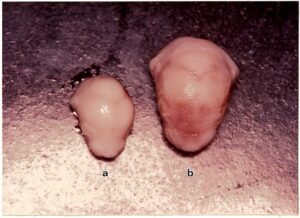
Figure 1: Heads of nicotine – treated (a): and untreated fetus; (b): Note the difference in head size and degree of development.
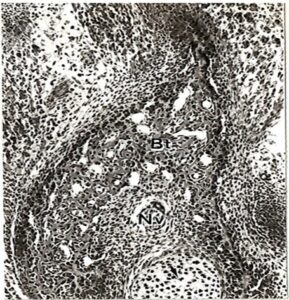
Figure 2: Mandible of nicotine-treated CD-1 fetus without cleft palate. Observe that the bony trabeculae (t) are narrow and poorly developed. The extent of the mandibular canal is indistinct, but is recognizable due to the presence of the inferior alveolar nerve and artery (Nv). Arrow head represents Meckel’s cartilage X 96.
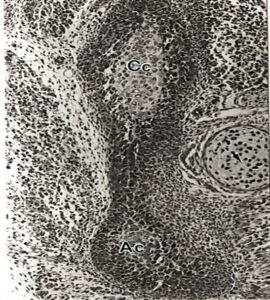
Figure 3: Condylar (Cc) and angular cartilage (Ac) of nicotine-treated CD-1 fetus without cleft palate. Observe that both cartilages are poorly developed X96.
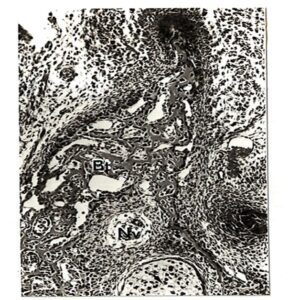
Figure 4: Mandible of nicotine – treated CD-1 fetus with cleft palate. Observe the poorly developed bony trabeculae and the indistinct extend of the mandibular camal X 96.
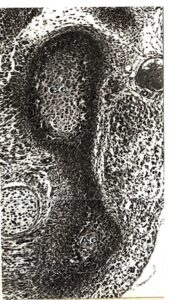
Figure 5: Condylar and angular cartilages of nicotine- treated CD-1 fetus with cleft palate. Observe that neither the condylar nor angular cartilage are well developed X 96.
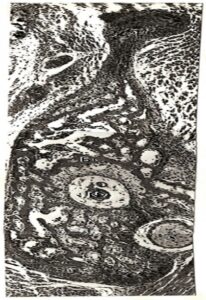
Figure 6: Mandible of untreated CD-1 fetus. Observe the considerable size of the bony trabeculae and numerous osteoblasts surrounding these trabeculae. The extent of the mandibular canal is clearly delineated X96.
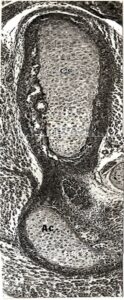
Figure 7: The condylar and angular cartilages of saline- treated fetus. Observe the large, well defined condylar and angular cartilages X96.
Discussion
It is well known that the developing fetus is highly sensitive to physical and chemical teratogenic agents during certain periods of pregnancy. This especially occur during the period of development and differential growth of various organs i.e. organogenesis [3,8,10,11]. In the current histologic investigation, this critical time in the CD-1 mouse appears to extend from approximately day 6 to day 15 of pregnancy. By day 18 of gestation most organs assume their final morphology and animals, in the present investigation, were sacrificed on that day. Parallel findings were reported by several studies [12,15-17,19,20]. Moreover, an analysis of the effect of 0.1% nicotine sulfate at a dose of 1.67 mg/kg body weight injected to pregnant mice produced smaller fetal heads smaller than those of controls. A study by others reported similar result utilizing guinea pigs [8]. Supporting data by Durham et al. who demonstrated, in their single morphologic study, reduced mandibular ramus height as well as reduced mandibular body size and molar length. They added that this subsequently disturbed the normal growth of craniofacial complex [7]. Furthermore, head measurements of saline-treated group were less than those of untreated animals (Table 1), suggesting that handling, trauma and stress of injection may also affect head size. Studies by other investigators were in consistence with our research and reported parallel findings [8,12,15-17]. Histologic examination of serial coronal sections demonstrated variations and adverse effects of the bony elements in mandibles of nicotine treated fetuses when compared to those of controls. Undoubtedly, several other developmental anomalies have occurred in these experimental fetuses which were discussed before in previous articles [12,15-17,19,20]. Currently, only these parameters were examined. In addition, the present histologic work appears to be the only one in which prenatal mandibular osteogenesis was examined in-vivo. However, it is not possible to elucidate the specific mechanisms of action of nicotine. It is clear that craniofacial development is adversely affected by prenatal exposure to that substance [1-8].
Conclusion
These detrimental effects, as stated by Saad, is prenatal and extended postnatally. He added that nicotine may interfere with cellular maturation [19,20]. Abel also reported that nicotine is highly toxic and water and lipid soluble and, as a result, is distributed rapidly throughout all tissue and body fluids or as suggested by others who showed that nicotine may affect food absorption (nutrition – related mechanism) [8,10]. Accordingly, nicotine should be avoided, at least, during pregnancy.
Conflict of Interests
The authors have no conflict of interest to declare.
Acknowledgment
Authors would like to acknowledge the contribution of Dr. Elian Silverman, Dental School, University of Maryland, who assisted in the statistical analysis.
Data Availability
Are available upon request from the corresponding author.
References
- Sulik KK, Schoenwolf GC. Highlights of craniofacial morphogenesis in mammalian embryos, as revealed by scanning electron microscopy. Scanning Electron Microscopy. 1985;1(4):1735-52.
- Hall BK. Mandibular morphogenesis and craniofacial malformation. J Craniof Genet Dev Biol. 1982;2:309-22.
- Hall BK. The role of tissue interactions in growth of bone. in: factors and mechanisms influencing bone growth. New York: Alan R. Liss, Inc.: 1982;205-15.
- Gaunt, W. A.; The development of the teeth and jaws of the albino mouse. Acta Anat. 1964;57:115-51.
- Ramaesh T, Bard JBL.The growth and morphogenesis of the early mouse mandible: a quantitative analysis. J Anat. 2003;203(2):2013-22.
- Iyyanar PP, Qin C, Adhikari N, Liu H, Hu YC, Jiang R, et al. Developmental origin of the mammalian premaxilla. Dev Biol. 2023;503:1-9.
- Durham EL, Balog C, Howie RN, Boyce MA, Arand JR, Warren G, et al. Effects of nicotine exposure on murine mandibular development. PloSOne. 2019;14(6):e0218376..
- Louis TM, Muse PD, Burden HW, Becker RF, Lowrence IE. Effect of nicotine administration throughout pregnancy on fetal size, placental weight and fetal maternal endocrine parameters at term, IRCS Med Sci Biochem. 1981;9:726-7.
- Reznik G, Marquard G. Effect of cigarette smoke. inhalation during pregnancy in Sprague-Dawley rats. J Environ Pathol Toxicol. 1980;4:141-52.
- Abel EL. Smoking and reproduction: An annomated bibliography. Boca Raton, Florida: CRC Press, Inc. 1984;1-154.
- Nasrat HA, Al-Hicham GMM, Mahmood FA. Perinatal effects of nicotine. Biol Neonat.1986;49:8-14.
- Saad AY, Gartner LP, Hiatt JL. Teratogenic effects of nicotine on palate formation in mice. Biol Struc Morph. 1990;3(1):31-5.
- Kang P, Svoboda KK. Nicotine inhibits palatal fusion and modulates nicotinic receptors and the PI‐3 kinase pathway in medial edge epithelia. Orthod Cranio Res. 2003;6(3):129-42.
- Ozturk F, Shelden E, Sharma J, Canturk KM, Out HH, Nawshad A. Nicotine exposure during pregnancy results in persistent midline epithelial seam with improper palatal fusion. Nicotine Tob. Res. 2016;18:604-12.
- Gartner LP, Saad AY, Hiatt JL. Effect of nicotine on murine incisor development. J Biol Buccal. 1990;18:(2)83-8.
- Saad AYM, Gartner LP, Hiatt JL. Teratogenic effect of nicotine on first molar odontogenesis in the mouse. Acta Morphol Hung. 1991;39(2):87-96.
- Gartner LP, Saad AY, Hiatt JL. Effects of nicotine on tongue development in the CD-1 mouse. Europ J Morphol. 1997;35 (5):337-43.
- Chowdhury IG, Bromage TG. Effect of fetal exposure to nicotine on dental development of the laboratory rat. Anat Rc. 2000;258:397-405.
- Saad AY. Postnatal effects of nicotine on incisor development of albino mouse. J Oral Pathol Med. 1990;90:426-9.
- Saad AY. Postnatal effects of nicotine on first molar development in the CD-1 mouse. Acta Anat. 1991;140:(3)269-72.
- Khan MA, Provenza DV, Seibel W. The effects of nicotine on mouse first molar tooth germs in organ culture. J Biol Buccale. 1981;9(4):335-48.
- Gartner LP, Hiatt JL, Provenza DV. Effect of ionizing radiation on incisor development of the prenatal mouse. Acta Anat. 1977;98:367-75.
- Hiatt JL, Gartner LP, Provenza DV. SDH activity in the developing incisors of irradiated mouse fetuses. J Biol Buccale. 1979;7:331-40.
Article Type
Research Article
Publication History
Received Date: 30-06-2024
Accepted Date: 22-07-2024
Published Date: 29-07-2024
Copyright© 2024 by Saad AY and Gartner LP. All rights reserved. This is an open access article distributed under the terms of the Creative Commons Attribution License, which permits unrestricted use, distribution, and reproduction in any medium, provided the original author and source are credited.
Citation: Saad AY and Gartner LP. Effect of Nicotine Exposure on Mandibular Development of CD-1 Mouse Fetuses: A Histological Study. J Dental Health Oral Res. 2024;5(2):1-8.

Figure 1: Heads of nicotine – treated (a): and untreated fetus; (b): Note the difference in head size and degree of development.

Figure 2: Mandible of nicotine-treated CD-1 fetus without cleft palate. Observe that the bony trabeculae (t) are narrow and poorly developed. The extent of the mandibular canal is indistinct, but is recognizable due to the presence of the inferior alveolar nerve and artery (Nv). Arrow head represents Meckel’s cartilage X 96.

Figure 3: Condylar (Cc) and angular cartilage (Ac) of nicotine-treated CD-1 fetus without cleft palate. Observe that both cartilages are poorly developed X96.

Figure 4: Mandible of nicotine – treated CD-1 fetus with cleft palate. Observe the poorly developed bony trabeculae and the indistinct extend of the mandibular camal X 96.

Figure 5: Condylar and angular cartilages of nicotine- treated CD-1 fetus with cleft palate. Observe that neither the condylar nor angular cartilage are well developed X 96.

Figure 6: Mandible of untreated CD-1 fetus. Observe the considerable size of the bony trabeculae and numerous osteoblasts surrounding these trabeculae. The extent of the mandibular canal is clearly delineated X96.

Figure 7: The condylar and angular cartilages of saline- treated fetus. Observe the large, well defined condylar and angular cartilages X96.
Measurements | Mean ± SD |
|
| ||
Nicotine | Saline | Un-injected | F Ratio | Probability | |
(N=166) | (M=198) | (N=232) |
|
| |
Head Width (mm) | 5.3 ± 0.4 | 6.4 ± 0.5 | 6.8 ± 0.3 | 197.302 | <0.00001 |
Head Height (mm) | 5.1 ± 0.4 | 6.2 ± 0.3 | 6.5 ± 0.4 | 174.875 | <0.00001 |
Head Circumference (mm) | 18.2 ± 0.1 | 20.5 ± 0.1 | 21.4 ± 0.2 | 255.71 | <0.00001 |
One Way ANOVA; Duncan’s Multiple Range Test;* Brackets define significant differences between groups | |||||
Table 1: Effects of nicotine on head size of 18-day CD-I fetuses.


